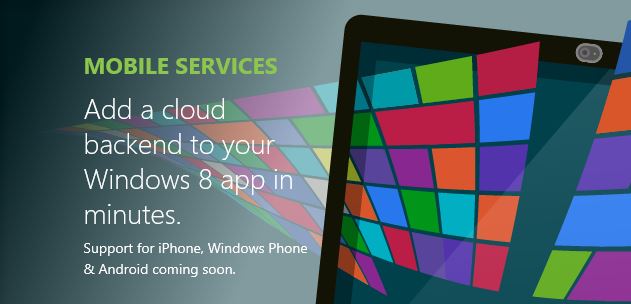Microsoft is looking to make it easier for developers to add back-end Windows Azure support to their client and mobile applications, starting with those running on Windows 8.
The new Windows Azure Mobile Services capability — a free preview of which was announced by Microsoft on August 28 — is the vehicle for this.
Update: To try this out, those with an existing Azure account will need to request to enroll in the preview. Those signing up for a brand new 90-day free trial of Azure will just be able to access the new preview automatically. Another caveat: “During preview, Mobile Services are free for your first ten Windows 8 applications running on shared instances.”
Azure Mobile Services allows developers to “easily store structured data in the cloud that can span both devices and users, integrate it with user authentication, as well as send out updates to clients via push notifications,” explained Scott Guthrie, now Corporate Vice President, Program Management for Server and Tools, in a blog post announcing Windows Azure Mobile Services.
Microsoft is planning to go beyond Windows 8, adding support to Azure Mobile Services for Windows Phone, iOS, and Android devices “soon.” (I’ve asked company officials for further delivery-time clarity.)
The new services make it “incredibly easy to connect client applications to the cloud, and enables client developers who don’t have a server-code background to be productive from the very beginning,” Guthrie said. “They can instead focus on building the client app experience, and leverage Windows Azure Mobile Services to provide the cloud backend services they require.”
Over the past several months, the Azure team has been rolling out mobile toolkits for iOS, Android and Windows Phone. These toolkits also aimed to simplify the connection of Microsoft- and non-Microsoft-developed mobile platforms to Windows Azure. I’ve asked whether the new Azure Mobile Services are designed to complement or replace these toolkits. If and when I hear back, I’ll update this post with Microsoft’s answer.
Update No. 2: Yes, the new Azure Mobile Services capability is going to supersede the multiplatform mobile toolkits, a spokesperson confirmed. Here’s the official statement:
“The Windows Azure mobile toolkits were the first iteration of support for the Mobile + Cloud scenario. ]We have incorporated the learnings and feedback from those efforts into Windows Azure Mobile Services. Future improvements will be channeled into Windows Azure Mobile Services rather than the original mobile toolkits.”
Microsoft posted a Channel 9 video of Guthrie demonstrating how to use the Windows Azure Mobile Services preview. There’s more information on the Windows Azure Mobile Services development portal, as well.
Via: ZDNet
More: MSDN Blogs, TechCrunch, BetaNews, Computerworld, The Register, WMPoweruser













